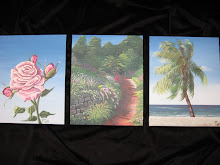Colors
First you'll want to choose your colors. There are no hard-and-fast rules here. You can choose colors that are relatively close on the color wheel or you can choose any combination of colors that you think will be pleasing to you and will create the effect you're hoping to achieve. The more radical the color difference, the more bold your ragging statement will be.
Once you've finishing painting your wall with your base coat, let it dry completely. This will generally take about twenty-four hours, but once it's dry, you're ready to begin ragging the top coat.
Ragging
Wearing a pair of rubber gloves to keep your hands from getting coated, start by dipping your lint-free rag into your top coat, which will be composed of a four-to-one mixture of glaze and the color of your choice. As you work, don't forget to stir the glaze/paint mixture occasionally, because it will have a tendency to separate as time goes by.
Squeeze out the excess paint and then open your rag completely to evenly distribute the mixture before loosely crumpling it again. Start at the top corner of the wall and press your rag down gently. Work in an area of about one square yard before moving on. As you move along, uncrumple your rag from time to time to vary the pattern. Remember, this is a unique work of art you're creating. You don't want it to look like wallpaper.
After you've recrumpled the rag several times, repeat the process of dipping, opening and recrumpling your rag, and dabbing paint onto the wall until you've finished the entire surface. If you're doing several walls, you'll get the best results if you work on opposite walls first. Take a few steps back from time to time to check the uniformity of your ragging texture.
For a crisper texture, you can use a polyester rag instead of a cotton one. Plastic grocery bags also give a rougher texture. Regardless of which type of rag you choose, the key to a great-looking wall is to take your time and strive to achieve a random, yet uniform texture across the entire surface. It's not an expensive remodeling technique and it will take time to do, but with patience, you can dramatically change the look of a room by giving it a unique texture--one that you can proudly tell your guests you created yourself!
For professional decorative wall finishes, take a look at the Faux Artists who worked on the Habitat for Humanity project on http://flipthathousewithfaux.com/
Copyright © 2007 Jeanette Fisher
Article Source: http://EzineArticles.com/?expert=Jeanette_Joy_Fisher
Video:
How to Faux Paint : Beginner Faux Painting Workshop Online : How to Use Rags for Faux Painting : Faux Painting Tips and Techniques
Learn how to use rags for faux painting, in this free video.
 WallDreams Paint Ideas! Some cool tools for ragging are different textures in the cloth being dabbled or rolled on or off the surface. Again, its always better to practice your technique on a practice board before committing to the entire room. Likewise, try bubblewrap, terrycloth, sheets, plastic sheeting, burlap, cheesecloth, torn up t-shirts, a specialty rag rolling roller cover from a paint store, etc. Once you've put glaze to wall and begun a technique, stay on target. You can not change tool or stop mid-wall or the finish will be different. And as for any technique, do pull back occasionally and check for quality assurance, consistency.
WallDreams Paint Ideas! Some cool tools for ragging are different textures in the cloth being dabbled or rolled on or off the surface. Again, its always better to practice your technique on a practice board before committing to the entire room. Likewise, try bubblewrap, terrycloth, sheets, plastic sheeting, burlap, cheesecloth, torn up t-shirts, a specialty rag rolling roller cover from a paint store, etc. Once you've put glaze to wall and begun a technique, stay on target. You can not change tool or stop mid-wall or the finish will be different. And as for any technique, do pull back occasionally and check for quality assurance, consistency.














No comments:
Post a Comment